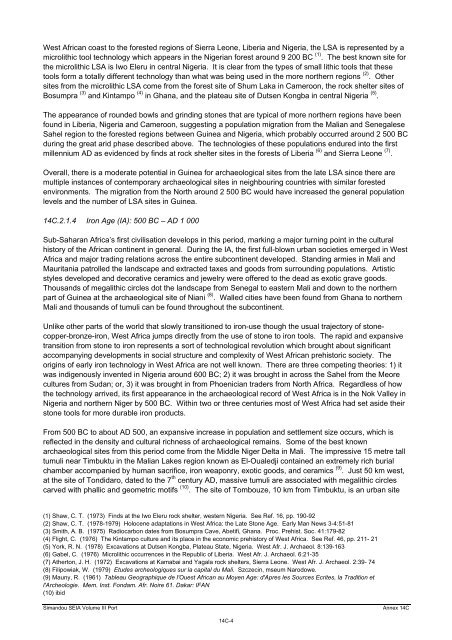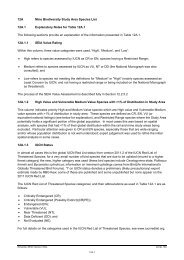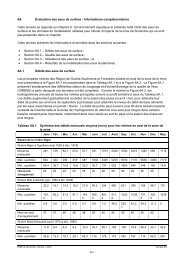Annex 14C: Cultural Context for West Africa and Guinea - Rio Tinto ...
Annex 14C: Cultural Context for West Africa and Guinea - Rio Tinto ...
Annex 14C: Cultural Context for West Africa and Guinea - Rio Tinto ...
Create successful ePaper yourself
Turn your PDF publications into a flip-book with our unique Google optimized e-Paper software.
<strong>West</strong> <strong>Africa</strong>n coast to the <strong>for</strong>ested regions of Sierra Leone, Liberia <strong>and</strong> Nigeria, the LSA is represented by a<br />
microlithic tool technology which appears in the Nigerian <strong>for</strong>est around 9 200 BC (1) . The best known site <strong>for</strong><br />
the microlithic LSA is Iwo Eleru in central Nigeria. It is clear from the types of small lithic tools that these<br />
tools <strong>for</strong>m a totally different technology than what was being used in the more northern regions (2) . Other<br />
sites from the microlithic LSA come from the <strong>for</strong>est site of Shum Laka in Cameroon, the rock shelter sites of<br />
Bosumpra (3) <strong>and</strong> Kintampo (4) in Ghana, <strong>and</strong> the plateau site of Dutsen Kongba in central Nigeria (5) .<br />
The appearance of rounded bowls <strong>and</strong> grinding stones that are typical of more northern regions have been<br />
found in Liberia, Nigeria <strong>and</strong> Cameroon, suggesting a population migration from the Malian <strong>and</strong> Senegalese<br />
Sahel region to the <strong>for</strong>ested regions between <strong>Guinea</strong> <strong>and</strong> Nigeria, which probably occurred around 2 500 BC<br />
during the great arid phase described above. The technologies of these populations endured into the first<br />
millennium AD as evidenced by finds at rock shelter sites in the <strong>for</strong>ests of Liberia (6) <strong>and</strong> Sierra Leone (7) .<br />
Overall, there is a moderate potential in <strong>Guinea</strong> <strong>for</strong> archaeological sites from the late LSA since there are<br />
multiple instances of contemporary archaeological sites in neighbouring countries with similar <strong>for</strong>ested<br />
environments. The migration from the North around 2 500 BC would have increased the general population<br />
levels <strong>and</strong> the number of LSA sites in <strong>Guinea</strong>.<br />
<strong>14C</strong>.2.1.4 Iron Age (IA): 500 BC – AD 1 000<br />
Sub-Saharan <strong>Africa</strong>’s first civilisation develops in this period, marking a major turning point in the cultural<br />
history of the <strong>Africa</strong>n continent in general. During the IA, the first full-blown urban societies emerged in <strong>West</strong><br />
<strong>Africa</strong> <strong>and</strong> major trading relations across the entire subcontinent developed. St<strong>and</strong>ing armies in Mali <strong>and</strong><br />
Mauritania patrolled the l<strong>and</strong>scape <strong>and</strong> extracted taxes <strong>and</strong> goods from surrounding populations. Artistic<br />
styles developed <strong>and</strong> decorative ceramics <strong>and</strong> jewelry were offered to the dead as exotic grave goods.<br />
Thous<strong>and</strong>s of megalithic circles dot the l<strong>and</strong>scape from Senegal to eastern Mali <strong>and</strong> down to the northern<br />
part of <strong>Guinea</strong> at the archaeological site of Niani (8) . Walled cities have been found from Ghana to northern<br />
Mali <strong>and</strong> thous<strong>and</strong>s of tumuli can be found throughout the subcontinent.<br />
Unlike other parts of the world that slowly transitioned to iron-use though the usual trajectory of stonecopper-bronze-iron,<br />
<strong>West</strong> <strong>Africa</strong> jumps directly from the use of stone to iron tools. The rapid <strong>and</strong> expansive<br />
transition from stone to iron represents a sort of technological revolution which brought about significant<br />
accompanying developments in social structure <strong>and</strong> complexity of <strong>West</strong> <strong>Africa</strong>n prehistoric society. The<br />
origins of early iron technology in <strong>West</strong> <strong>Africa</strong> are not well known. There are three competing theories: 1) it<br />
was indigenously invented in Nigeria around 600 BC; 2) it was brought in across the Sahel from the Meore<br />
cultures from Sudan; or, 3) it was brought in from Phoenician traders from North <strong>Africa</strong>. Regardless of how<br />
the technology arrived, its first appearance in the archaeological record of <strong>West</strong> <strong>Africa</strong> is in the Nok Valley in<br />
Nigeria <strong>and</strong> northern Niger by 500 BC. Within two or three centuries most of <strong>West</strong> <strong>Africa</strong> had set aside their<br />
stone tools <strong>for</strong> more durable iron products.<br />
From 500 BC to about AD 500, an expansive increase in population <strong>and</strong> settlement size occurs, which is<br />
reflected in the density <strong>and</strong> cultural richness of archaeological remains. Some of the best known<br />
archaeological sites from this period come from the Middle Niger Delta in Mali. The impressive 15 metre tall<br />
tumuli near Timbuktu in the Malian Lakes region known as El-Oualedji contained an extremely rich burial<br />
chamber accompanied by human sacrifice, iron weaponry, exotic goods, <strong>and</strong> ceramics (9) . Just 50 km west,<br />
at the site of Tondidaro, dated to the 7 th century AD, massive tumuli are associated with megalithic circles<br />
carved with phallic <strong>and</strong> geometric motifs (10) . The site of Tombouze, 10 km from Timbuktu, is an urban site<br />
(1) Shaw, C. T. (1973) Finds at the Iwo Eleru rock shelter, western Nigeria. See Ref. 16, pp. 190-92<br />
(2) Shaw, C. T. (1978-1979) Holocene adaptations in <strong>West</strong> <strong>Africa</strong>: the Late Stone Age. Early Man News 3-4:51-81<br />
(3) Smith, A. B. (1975) Radiocarbon dates from Bosumpra Cave, Abetifi, Ghana. Proc. Prehist. Soc. 41:179-82<br />
(4) Flight, C. (1976) The Kintampo culture <strong>and</strong> its place in the economic prehistory of <strong>West</strong> <strong>Africa</strong>. See Ref. 46, pp. 211- 21<br />
(5) York, R. N. (1978) Excavations at Dutsen Kongba, Plateau State, Nigeria. <strong>West</strong> Afr. J. Archaeol. 8:139-163<br />
(6) Gabel, C. (1976) Microlithic occurrences in the Republic of Liberia. <strong>West</strong> Afr. J. Archaeol. 6:21-35<br />
(7) Atherton, J. H. (1972) Excavations at Kamabai <strong>and</strong> Yagala rock shelters, Sierra Leone. <strong>West</strong> Afr. J. Archaeol. 2:39- 74<br />
(8) Filipowiak, W. (1979) Etudes archeologiques sur la capital du Mali. Szczecin, mseum Narodowe.<br />
(9) Mauny, R. (1961) Tableau Geographique de l'Ouest <strong>Africa</strong>n au Moyen Age: d'Apres les Sources Ecrites, la Tradition et<br />
l'Archeologie. Mem. Inst. Fondam. Afr. Noire 61. Dakar: IFAN<br />
(10) ibid<br />
Sim<strong>and</strong>ou SEIA Volume III Port <strong>Annex</strong> <strong>14C</strong><br />
<strong>14C</strong>-4










